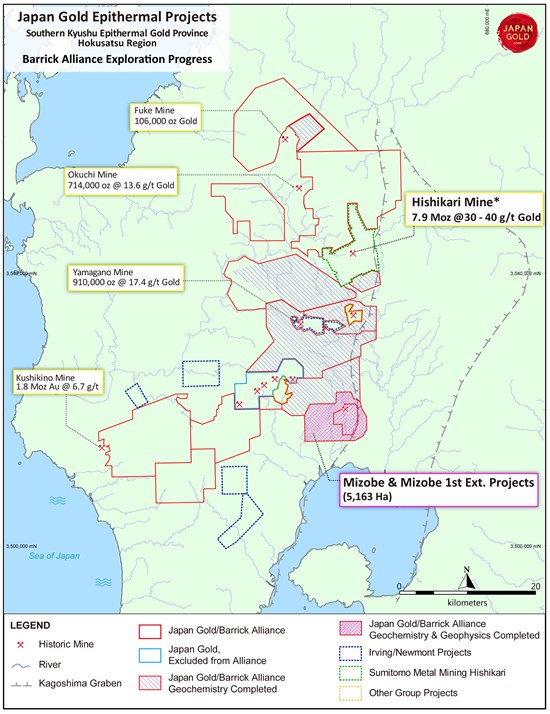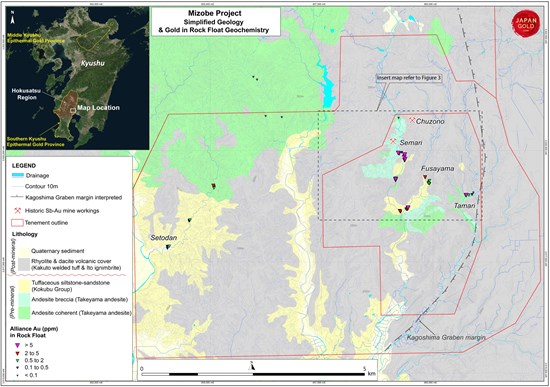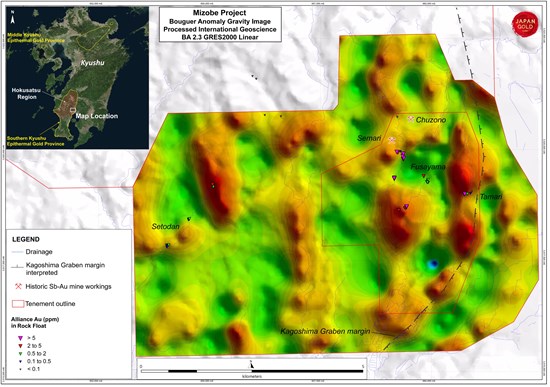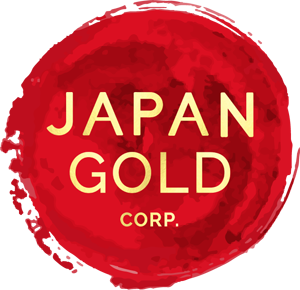Japan Gold Announces Surface Sampling Results from Barrick Alliance - Mizobe Project Regional Program; 22 of 84 Rock Float Samples + 4g/t Gold
Vancouver, British Columbia--(Newsfile Corp. - September 30, 2020) - Japan Gold Corp. (TSXV: JG) (OTCQB: JGLDF) (the "Company") is pleased to report encouraging geochemical and geophysical results from the Barrick Alliance regional work programs covering the Mizobe Project in the Southern Kyushu Epithermal Gold Province.
Highlights:
- The Barrick Alliance regional programs, currently in progress, will cover all 29 projects (collectively approximately 1,600 square km) and include:
- Geochemistry - multielement geochemical stream sediment surveying, bulk leach extractable gold (BLEG) analysis and rock float sampling
- Geophysics - gravity surveys
- The Mizobe Project has been covered by both geochemistry and geophysics
Mizobe Project Results
- 84 rock float samples collected with 54 assaying gold greater than 0.5 g/t Au including 22 assaying greater than 4 g/t Au with a peak value of 18.9 g/t Au
- Several gravity-high features defined across the project coincide with at least four clusters of gold in rock float anomalies
- Gravity data has undergone additional processing for structure detection and has identified several favorably oriented northeast trending features associated with gravity-highs
Japan Gold's VP Exploration, Andrew Rowe, commented, "It's very encouraging to see evidence of a well preserved and potentially extensive gold-bearing epithermal system at this early stage of the Barrick Alliance regional programs. Similarities in structural setting to the nearby Hishikari gold mine highlight the Mizobe Project's prospectivity."
Mizobe Project
The Mizobe Project, which includes the Mizobe and Mizobe 1st Extension, is located along the western edge of the Kagoshima Graben in the gold-fertile Hokusatsu Region, Japan's largest gold producing region, with more than 11 million ounces of combined production from low-sulphidation epithermal deposits2,3,4,5. The Mizobe Project covers 5,163.1 hectares and forms part of a larger contiguous project package covering 96,227 hectares or 80% of the prospective, explorable ground in the Hokusatsu Region (Figure 1).
Historic mining activities were focused on antimony mineralization in the northeast at the Semari and Chuzono Mines, Figure 2. Antimony is an important pathfinder element for low-sulphidation epithermal gold mineralization and is commonly concentrated in the upper parts of the system above the main zones of gold precipitation.
Barrick Alliance Work Program
Rock Sampling
As part of Barrick Alliance regional assessment programs, stream sediment sampling, BLEG analysis, rock float sampling, and semi-detailed gravity surveying have been completed across the Mizobe Project (Figure 1). Of 84 rock float samples collected within the project 54 gave gold assays greater than 0.5 g/t Au including 22 which yielded results greater than 4 g/t Au, with a peak value of 18.9 g/t Au. Pathfinder elements including antimony are also strongly anomalous (Table 1).
Rock float sampling has confirmed several known anomalous drainage basins including those containing the historic Semari and Chuzono antimony mines, as well as highlighting two new anomalous catchments, the Tamari valley and the Setodan valley on the western side of the project and the Fusayama valley, one km west of the Tamari valley, (Figures 2 and 3).
Anomalous rock samples collected comprise quartz-sulphide hydrothermal breccias, proximal to the Semari workings, and banded quartz vein style mineralization prevalent in the Fusayama and Tamari areas southeast of the historic workings. Strong antimony-gold anomalism and the superimposition of banded quartz veins on hydrothermal breccia, indicate the exposure of the upper portions of a gold bearing epithermal system. Deeper gold-rich feeder veins of the epithermal system will be the target of future exploration. The level and extent of the gold and antimony anomalism is highly encouraging as there is limited exposure of pre-mineralization host rock with much of the project area being covered by post-mineral volcanic ash (Figure 2).
The BLEG sample assay results are pending and will help to further identify and refine anomalous catchments within the Mizobe Project and across the Hokusatsu Region.
Gravity Surveying
The close relationship between gravity-highs and the major low-sulphidation epithermal gold deposits in the Hokusatsu Region is well described in geological literature1. Uplift or doming of the underlying basement, inferred to produce the gravity anomalies, is interpreted as a key factor in localising the development of east-northeast to northeast trending fracture networks that host the gold-bearing epithermal quartz-vein systems. Encouragingly, several gravity-high anomalies defined across the Mizobe Project oject coincide with at least four clusters of gold in rock float and outcrop anomalies (Figure 4).
The gravity survey data will assist in understanding structural controls favorable to mineralization at both regional and project scales. Sophisticated processing of the gravity data to enhance detection of faults which control gold mineralization has been undertaken and this will support targeting more focussed geophysical surveys such as CSAMT, and subsequent drilling. This work has identified favorably oriented northeast to east-northeast trending features close to gravity-high anomalies in the Fusayama valley; the historic Semari antimony mine; and the Tamari and Setodan Valleys (Figure 5). The Kagoshima-Graben margin is clearly defined on the eastern side of the project and the Hishikari and Yamagano Mines, are also located proximal to this deep crustal-structure (Figure 1).
References
1 Feebrey et.al., (1998) Geophysical Expression of Low Sulphidation Epithermal Au-Ag Deposits and Exploration Implications- Examples from the Hokusatsu Region of SW Kyushu, Japan. Resource Geology, vol. 48, no. 2, pp 75-86, 1998.
2 Watanabe Y, 2005. Late Cenozoic evolution of epithermal gold metallogenic provinces in Kyushu, Japan. Mineralium Deposita (2005) 40: pp 307-323.
3 Sumitomo Metal Mining Co., LTD. website, production as of end of March 2020.
4 Garwin, S.G. et al. 2005. Tectonic setting, Geology, and gold and copper mineralization in the Cenozoic magmatic arcs of Southeast Asia and the West Pacific. Economic Geology 100th Anniversary Vol. pp 891-930.
5MITI (1999): Report on the regional survey of the Hokusatsu-Kushikino region, Hesai 11, 12 & 13. Ministry of International Trade and Industry.
Sampling Techniques and Assaying
Rock results presented in this news release and accompanying figures are from 1-3 kg selected grabs of river float samples. The grab samples of float material reported in this announcement are believed to originate from the underlying bedrock of the drainage basin from which they were collected. The Company cautions that grab and float samples are selective by nature and may not be representative of typical mineralization on the property. Sample preparation and assaying were done by ALS Vancouver, BC, Canada. Samples were crushed and pulverised and gold was analysed by 50 gram-charge Fire Assay and AAS finish. A 48 multielement analysis including silver was done by four-acid digest and ICP-MS determination.
A Chain-of-Custody was established between the Company and receiving laboratory to ensure the integrity of the samples during transportation from site to the lab.
Certified Reference Materials (CRMs) were inserted by Japan Gold at every 20th sample to assess repeatability and assaying precision of the laboratory. In addition, the laboratory applied its own internal Quality Control procedure that includes sample duplicates, blanks & geochemical standards. They report these results with the certified Assay Report. Laboratory procedures and QAQC protocols adopted are considered appropriate. The CRMs and internal QC-QA results fall within acceptable levels of accuracy & precision and are considered to lack any bias.
Qualified Person
The technical information in this news release has been reviewed and approved by Japan Gold's Vice President of Exploration, Andrew Rowe, BAppSc, FAusIMM, FSEG, who is a Qualified Person as defined by National Instrument 43-101.
On behalf of the Board of Japan Gold Corp.
"John Proust"
Chairman & CEO
About Japan Gold Corp.
Japan Gold Corp. is a Canadian mineral exploration company focused solely on gold exploration across the three largest islands of Japan: Hokkaido, Honshu and Kyushu. The Company has a country-wide alliance with Barrick Gold Corporation to jointly explore, develop and mine certain gold mineral properties and mining projects. The Company holds a portfolio of 31 gold projects which cover areas with known gold occurrences, a history of mining and are prospective for high-grade epithermal gold mineralization. Japan Gold's leadership team represent decades of resource industry and business experience, and the Company has recruited geologists, drillers and technical advisors with experience exploring and operating in Japan. More information is available at www.japangold.com or by email at This email address is being protected from spambots. You need JavaScript enabled to view it.
For further information, please contact:
John Proust
Chairman & CEO
Phone: 778-725-1491
Email: This email address is being protected from spambots. You need JavaScript enabled to view it.
Cautionary Note
Neither the TSX Venture Exchange nor its Regulation Services Provider (as such term is defined in the policies of the TSX Venture Exchange) accepts responsibility for the adequacy or accuracy of this release. This news release contains forward-looking statements relating to expected or anticipated future events and anticipated results related to future partnerships and the Company's 2020 gold exploration program. These statements are forward-looking in nature and, as a result, are subject to certain risks and uncertainties that include, but are not limited to, general economic, market and business conditions; competition for qualified staff; the regulatory process and actions; technical issues; new legislation; potential delays or changes in plans; working in a new political jurisdiction; results of exploration; the timing and granting of prospecting rights; the Company's ability to execute and implement future plans, arrange or conclude a joint-venture or partnership; and the occurrence of unexpected events. Actual results achieved may differ from the information provided herein and, consequently, readers are advised not to place undue reliance on forward-looking information. The forward-looking information contained herein speaks only as of the date of this News Release. The Company disclaims any intention or obligation to update or revise forward‐looking information or to explain any material difference between such and subsequent actual events, except as required by applicable laws.
Table 1: Significant Rock Float Anomalies greater than 1 g/t Gold
| Sample No. | Gold (g/t) | Silver (g/t) | Antimony (ppm) |
Ag:Au Ratio |
| 021040 | 18.9 | 9.2 | 1,735 | 0.5 |
| 021046 | 18.8 | 48.0 | >10,000 | 2.6 |
| 020561 | 10.5 | 0.7 | 126 | 0.1 |
| 021049 | 9.4 | 7.7 | 1,705 | 0.8 |
| 020508 | 9.3 | 13.3 | 3,920 | 1.4 |
| 021050 | 7.9 | 77.7 | 435 | 9.8 |
| 020506 | 7.5 | 27.3 | >10,000 | 3.6 |
| 020503 | 7.1 | 8.9 | 6,140 | 1.3 |
| 021041 | 7.0 | 9.4 | 1,490 | 1.3 |
| 020501 | 6.6 | 5.8 | 999 | 0.9 |
| 020512 | 6.4 | 7.9 | 197 | 1.2 |
| 021045 | 6.3 | 16.5 | 446 | 2.6 |
| 021022 | 6.3 | 11.9 | 286 | 1.9 |
| 020502 | 5.7 | 59.8 | 887 | 10.5 |
| 021023 | 5.2 | 49.8 | 636 | 9.7 |
| 020504 | 5.1 | 84.4 | 1,120 | 16.5 |
| 021021 | 4.5 | 9.6 | 180 | 2.1 |
| 020505 | 4.3 | 76.9 | 838 | 17.8 |
| 021048 | 4.3 | 8.3 | 314 | 1.9 |
| 020514 | 4.2 | 20.5 | 396 | 4.9 |
| 021042 | 4.1 | 11.1 | 363 | 2.7 |
| 021047 | 4.0 | 21.3 | 284 | 5.4 |
| 020527 | 3.3 | 4.5 | 118 | 1.4 |
| 020562 | 3.3 | 0.3 | 73 | 0.1 |
| 021025 | 2.4 | 5.9 | 40 | 2.5 |
| 021038 | 2.2 | 19.8 | 87 | 9.2 |
| 021018 | 2.0 | 2.4 | 123 | 1.2 |
| 021044 | 1.9 | 34.8 | 323 | 17.9 |
| 020507 | 1.8 | 3.1 | 136 | 1.7 |
| 021028 | 1.5 | 3.2 | 27 | 2.1 |
| 020510 | 1.5 | 3.3 | 121 | 2.1 |
| 021027 | 1.5 | 3.8 | 41 | 2.5 |
| 021020 | 1.4 | 1.2 | 114 | 0.9 |
| 021008 | 1.2 | 0.4 | 79 | 0.4 |
| 021011 | 1.1 | 1.5 | 103 | 1.3 |
| 020588 | 1.0 | 1.0 | 21 | 0.9 |

Figure 1: Barrick Alliance Project Portfolio in the Hokusatsu Region of Southern Kyushu, Mizobe Project is highlighted.
To view an enhanced version of Figure 1, please visit:
https://japangold.com/images/news_releases/2020/64919_4083850684883afe_001.jpg

Figure 2: Mizobe Project (Mizobe and Mizobe 1st Ext. combined), Simplified geology, and gold in rock float geochemistry.
To view an enhanced version of Figure 2, please visit:
https://japangold.com/images/news_releases/2020/64919_4083850684883afe_002.jpg

Figure 3: Mizobe Project (Semari-Fusayama-Tamari area), Simplified geology and gold in rock float geochemistry.
To view an enhanced version of Figure 3, please visit:
https://japangold.com/images/news_releases/2020/64919_4083850684883afe_003.jpg

Figure 4: Mizobe Project Bouguer gravity image: anomalous gravity-high features are red, anomalous gold in rock float geochemistry is closely associated with gravity-high features in the Setodan, Semari, Fusayama and Tamari areas.
To view an enhanced version of Figure 4, please visit:
https://japangold.com/images/news_releases/2020/64919_4083850684883afe_004.jpg

Figure 5: Mizobe Project, Bouguer gravity processed for structure detection. Anomalous gold in rock float and the historic antimony-gold mines are located close to northeast to east-northeast detected structures favorable to gold mineralization in the region.
To view an enhanced version of Figure 5, please visit:
https://japangold.com/images/news_releases/2020/64919_4083850684883afe_005.jpg

To view the source version of this press release, please visit https://www.newsfilecorp.com/release/64919

